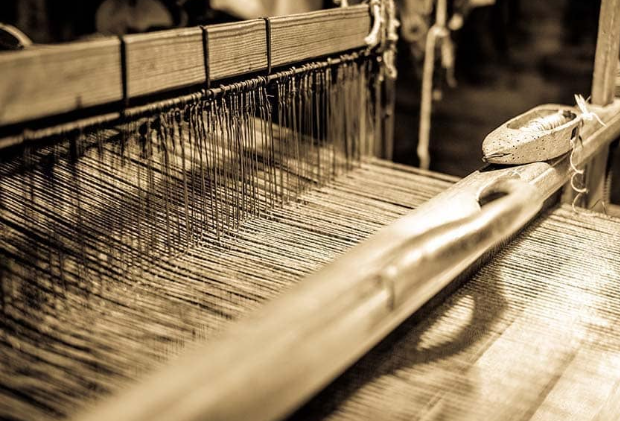Comparative Life Cycle Assessment Of Textile Fibres In Nepal - Cotton, Silk, And Hemp
Jul 08, 2025 | Rural Handmade
 This report presents a comparative Life Cycle Assessment (LCA) of three textile fibres widely used or produced in Nepal: cotton, silk, and hemp. The LCA covers the cradle-to-grave carbon footprint of each fibre, identifying emission hotspots and potential sustainability trade-offs.
This report presents a comparative Life Cycle Assessment (LCA) of three textile fibres widely used or produced in Nepal: cotton, silk, and hemp. The LCA covers the cradle-to-grave carbon footprint of each fibre, identifying emission hotspots and potential sustainability trade-offs. Cotton and silk have high GHG emissions per kilogram of fibre, mainly due to synthetic inputs, energy use, and post-consumer washing. Wool has moderate GHG emissions, mainly from enteric methane emissions from sheep rearing. Hemp, on the other hand, demonstrates net negative emissions due to high CO₂ uptake during cultivation, making it a promising alternative for sustainable textiles. The findings support decision-making for low-carbon textile production in Nepal.
1. Introduction
The textile industry in Nepal, though small-scale, plays a critical role in employment, cultural heritage, and exports. With growing awareness of environmental impacts, it is important to assess the sustainability of different textile fibres. This study aims to quantify and compare the life cycle greenhouse gas (GHG) emissions of cotton, wool, silk, and hemp fibres.
Image: GFG Emissions in Asia
Goal and Scope
-
Goal: To assess and compare the carbon footprints of cotton, wool, silk, and hemp textiles in Nepal.
-
Scope: Cradle-to-grave system boundary, including cultivation, processing, garment production, consumer use, and disposal.
-
Functional Unit: 1 kg of finished textile fibre.
2. Methodology
Emissions are expressed as kg CO₂-equivalents per kg fibre. Data is drawn from published literature and reports tailored to Nepalese or regional (South Asian) conditions. For comparability, consumer use (50 washing/drying cycles) and landfill disposal are standardised across fibres. Biogenic CO₂ uptake is considered in the hemp LCA.
3. Impact Assessment (LCIA)
The key impact category is climate change, specifically greenhouse gas (GHG) emissions. Silk exhibits the highest emissions primarily due to intensive inputs in cultivation and rearing, and reliance on traditional fuelwood in processing. Cotton's impact is concentrated in the consumer use stage, and wool’s impact is focused on the enteric methane emissions from sheep rearing. Hemp, in contrast, presents a carbon-negative footprint due to CO₂ absorption during cultivation.
Image: Energy consumption & environmental impact of textiles throughout the lifecycle
The table below summarises GHG emissions for all fibres.
|
Fiber |
Process |
GHG emissions (kg CO2 eq/kg) |
|---|---|---|
|
Silk |
||
|
Mulberry cultivation |
30 |
|
|
Silkworm rearing |
8 |
|
|
Silk reeling and processing |
35 |
|
|
Composting and waste |
2.9 |
|
|
Transport and other |
5 |
|
|
Total |
80.9 |
|
|
Cotton |
||
|
Cultivation |
3.7 |
|
|
Harvesting and ginning |
0.6 |
|
|
Transport |
0.4 |
|
|
Spinning |
2.46 |
|
|
Dyeing and finishing |
1.4 - 1.6 |
|
|
Garment manufacturing |
0.5 |
|
|
Consumer use |
10 - 12 |
|
|
Disposal phase |
0.2 - 0.5 |
|
|
Total |
20 - 22 |
|
|
Wool |
||
|
Wool production |
0.10727 |
|
|
Wool processing |
0.03995 |
|
|
Retail and transport |
0.00884 |
|
|
Garment care (washing, drying) |
0.01394 |
|
|
Total |
0.17 |
|
|
Hemp |
||
|
Hemp cultivation |
- 9.315 |
|
|
Transport |
0.067 |
|
|
Production |
4.968 |
|
|
Total |
- 4.28 |
4. Interpretation
-
Silk: Environmental impact is driven by high fertiliser use, methane emissions from manure, and energy-intensive reeling.
-
Cotton: Emissions are more evenly distributed, with consumer use as the primary hotspot.
-
Hemp: Offers the lowest (net negative) emissions, but may not fully reflect real-world garment processing emissions.
-
Wool: Major emissions come from enteric methane produced by sheep, but it has overall low emissions.
Assumptions include standardised washing cycles, energy mixes, and system boundaries. Data uncertainties exist, particularly around consumer use and energy sources.
5. Conclusion & Recommendations
Image: Cradle to grave lifecycle of textile
Among the four textile fibres assessed:
-
Hemp is the most environmentally sustainable option, offering net negative emissions due to its high carbon uptake.
-
Cotton has a moderate impact, with opportunities to reduce emissions through organic practices and consumer education.
-
Wool is also moderately impactful, with opportunities to reduce enteric methane through different interventions like dietary reformulation.
-
Silk has the highest emissions, and sustainability improvements should target manure management, alternative fuels, and energy efficiency.
Stakeholders in Nepal's textile industry can use these insights to promote climate-friendly practices and prioritise investment in sustainable fibre alternatives like hemp.
6. Reference
Rana, S., Karunamoorthy, S., Parveen, S. & Fangueiro, R. (2015) Life cycle assessment of cotton textiles and clothing. In: Muthu, S.S. (ed.) Handbook of Life Cycle Assessment (LCA) of Textiles and Clothing. Woodhead Publishing Series in Textiles. Elsevier Inc., pp. 195–216. doi: 10.1016/B978-0-08-100169-1.00009-5
Ren, D., Colosi, L.M. & Smith, J.A. (2013) “Evaluating the sustainability of ceramic filters for point-of‑use drinking water treatment”, Environmental Science & Technology, 47(20), pp. 11206–11213. doi: 10.1021/es4026084.
Sinha, S.K. & Michaelowa, A. (2014) Life cycle assessment of Indian silk. Journal of Cleaner Production, 65, pp. 1–10. doi: 10.1016/j.jclepro.2014.06.007
Wiedemann, S.G., Biggs, L., Nebel, B., Bauch, K., Laitala, K., Klepp, I.G., Swan, P.G. & Watson, K. (2020) “Environmental impacts associated with the production, use, and end‑of‑life of a woollen garment”, The International Journal of Life Cycle Assessment, 25(8), pp. 1486–1499. doi: 10.1007/s11367‑020‑01766‑0.
Recommended








